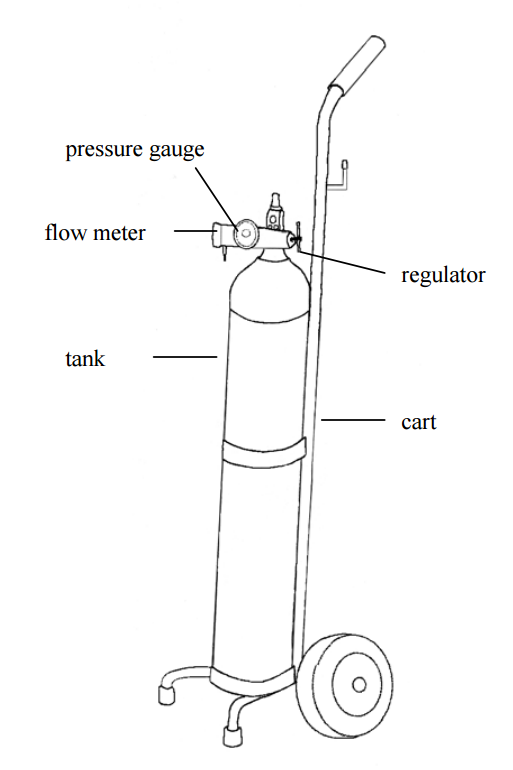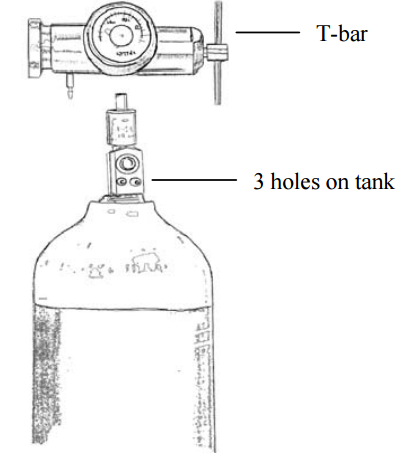Oxygen safety at home
Article Translations: (Spanish)
What is oxygen?
Oxygen (often called O2) is a colorless, odorless gas that is part of the air we breathe. It is essential for all cells in our body and helps healing.
Sometimes, children who have breathing problems need extra oxygen. This makes them feel better because they don't have to breathe harder or faster to get enough oxygen. Your child may have two types of oxygen systems:
- oxygen concentrator, for home use only
- portable oxygen: either an oxygen tank or liquid oxygen
The type of oxygen system is prescribed to meet your child's needs.
What are the risks of oxygen?
When oxygen is in use, there is an increased risk of fire. Each type of oxygen system has other safety issues as well as the danger of fire. For example, oxygen tanks and liquid oxygen vessels contain oxygen under pressure, which can cause injury if not used correctly.
Make sure you understand completely how to use the oxygen equipment. Ask your nurse, doctor, or medical equipment company as many questions as needed.
What should I do?
A doctor's prescription is required. Think of oxygen as a medicine. Do not change the liter flow (amount of oxygen flowing through the tubing) without talking with your home care nurse, doctor, or respiratory care practitioner.
Be sure to have at least a three-day supply of portable oxygen on hand, so that it does not run out. Your respiratory care practitioner or oxygen supplier can help you determine what a three-day supply is for your child, and will help you arrange a routine delivery schedule.
Keep the oxygen tubing in sight. Do not put the tubing under furniture, bed covers, carpets, clothing, or other items. This could kink the tube and prevent the flow of oxygen through the tubing.
Prevent fires
Do not allow smoking in your home, car, or other places where your child is receiving oxygen. Post "No Smoking" and "Oxygen in Use" signs on the entrances to your home.
Do not leave oxygen on when not in use.
When the oxygen is on, keep it and your child at least 10 feet away from fireplaces, stoves, or gas appliances (dryer, hot water heater).
Do not let your child play with toys that have friction motors or that give off sparks.
Do not use electrical equipment in an oxygen-enriched environment. Examples include electric razors, hairdryers, electric blankets, or electric heaters. Electrical equipment may spark and cause a fire. Cell phones are okay.
Do not use flammable products such as paint thinner, rubbing alcohol, or oil-based products such as Vaseline® near the oxygen. Use a water-based lubricant such as K-Y® jelly to moisten your child's lips or nose.
Prevent injury
Prevent oxygen tanks or liquid oxygen vessels from falling. A falling tank or vessel is very dangerous. If it falls over or is dropped, it might break, causing the pressurized oxygen to escape rapidly. This pressure can cause the tank or vessel to fly through the air.
Always keep oxygen tanks or liquid oxygen vessels upright in a cart, rack, or stable base. Never tip them on their side. Do not use tanks or vessels that have fallen or are damaged.
Store out of direct sunlight and in a well aired space.
When moving an oxygen tank or vessel, always use a shoulder bag or wheeled cart.
Traveling with oxygen
Be very careful when traveling with oxygen.
- No smoking in the car.
- Never put the oxygen into a hot vehicle.
- Never put the oxygen in the trunk.
- Secure the oxygen to avoid rolling or banging. For example, you could secure it with the seatbelt in the seat that is next to your child.
- Make sure there is air movement in the vehicle.
- Always take the most direct route.
- Try to avoid heavy traffic.
- When you arrive, remove the oxygen from your vehicle right away. Never leave it in a vehicle - it could get hot from the sun.
___ Using an oxygen concentrator
An oxygen concentrator is a device that separates the oxygen out of the air, concentrates it, and stores it in the machine. A nasal cannula (plastic tube) brings the oxygen to your child's nose.
Store and use the oxygen concentrator correctly
The oxygen concentrator needs electricity to work. Always plug it into a grounded outlet. Do not use an extension cord or power strip.
The concentrator produces heat. Keep it in an open area. Never put it in a closet or small, closed-in space.
The concentrator is not portable. Long lengths of oxygen tubing are used so your child can move around. Another type of oxygen system must be used for travel outside your home, or if the power goes out.
Taking care of the equipment
An oxygen concentrator is easy to maintain. Your medical equipment company will give you instructions on care and cleaning.
Please check with your medical equipment company to see how often your concentrator needs to be serviced.
___ Using liquid oxygen
When oxygen is cooled to an extremely low temperature (-297° F) the gas becomes a liquid. The liquid oxygen is kept in a vessel, like a large thermos, that keeps it cold. As long as liquid oxygen is inside of the vessel, it stays liquid. When it is released from the vessel, it turns into a gas again.
Liquid oxygen is often used for children who are quite active and go on frequent outings. It is convenient because the portable vessel can be refilled from a large vessel that you store in your home. Liquid oxygen vessels take up less space in your home than the compressed oxygen tanks do.
Refilling the portable oxygen vessel
Your medical equipment company will give you instructions on refilling the small vessel.
Liquid oxygen is extremely cold. Contact with liquid oxygen or its vapors can quickly freeze tissues. It is common to see vapors when filling a small vessel from the large vessel. The vapors evaporate quickly and then are harmless. To prevent injury:
- Never touch liquid oxygen, or the frosted parts of liquid oxygen vessels.
- Avoid getting the vapors in your face.
Taking care of the equipment
Your medical equipment company will give you instructions on care and cleaning.
___ Using an oxygen tank
An oxygen tank is a metal container filled with oxygen under high pressure. Oxygen tanks come in different sizes. The size used is based on your child's needs.
Terms:
Cracking the tank: opening the valve just enough to let a small amount of oxygen out, which will clear dirt out of the valve.
Crush gasket: a nylon washer that comes with each new tank of oxygen. When you set up an oxygen tank, take this off and throw it away.
Flow meter: measures the flow of oxygen coming out of the tank in liters per minute (LPM).
Nasal cannula: tubing that is connected to the oxygen tank and brings the flow of oxygen into your child's nose.
Pressure gauge: measures how much oxygen is in the tank. A full tank has between 1800 and 2200 pounds per square inch (PSI).
Regulator: a device that contains both the flow meter and the pressure gauge. It is attached to the tank, and lets the oxygen out at a safe pressure. Never carry a tank by the regulator. Never use any type of lubricant (oil or grease) on the regulator. This could cause a fire.
Sealing washer: a metal or metal-and- rubber washer that is used to provide a tight seal between the oxygen tank and the regulator. The sealing washer helps to prevent oxygen from leaking.
Parts of an oxygen tank set-up

Setting up the oxygen tank
- Wash your hands.
- Remove the white or blue plastic tape from the top of the tank. Remove and discard the disposable crush gasket.
• Caution: never use the crush gasket for setting up the tank. - Crack the tank:
• Point the oxygen outlet away from yourself and others.
• Place the wrench (included with the oxygen tank) on the valve on top of the tank.
• Turn the valve to the left (counterclockwise). A hissing sound means gas is coming out.
• Stop once you hear the hissing sound, and turn the valve off by turning it to the right (clockwise). Don't over tighten. - Always be sure the valve, regulator, and sealing washer are free of oil or grease. Oil or grease can cause a fire.
- Put the sealing washer on the tank.
- Put the regulator on the tank:
• Make sure the regulator's three pins are lined up to the three holes on the tank.
• Tighten the regulator onto the tank with the regulator's T-bar handle.
• Open the tank by turning the valve with the wrench one complete turn counterclockwise. Turn the wrench slowly.
• If you hear a loud hissing sound, this means there is a leak. Close the tank right away by turning the wrench clockwise. Call your oxygen supply company right away. - Check the pressure gauge.
- Place the oxygen tubing on the regulator's outlet.
- Turn the flow meter knob to the LPM setting prescribed by your child's doctor.
Note: When turning on the oxygen tank, wait until the valve is fully open, to get an accurate reading of how much oxygen is in the tank.
What else do I need to know?
If you think there is a problem with your oxygen system, do not try to fix it. Call your equipment company for help.
Questions?
This is not specific to your child, but provides general information. If you have any questions, please call your medical equipment company.
Children's Hospitals and Clinics of Minnesota
Last reviewed 8/2015
This page is not specific to your child, but provides general information on the topic above. If you have any questions, please call your clinic. For more reading material about this and other health topics, please call or visit Children's Minnesota Family Resource Center library, or visit www.childrensmn.org/educationmaterials.
© 2024 Children's Minnesota
